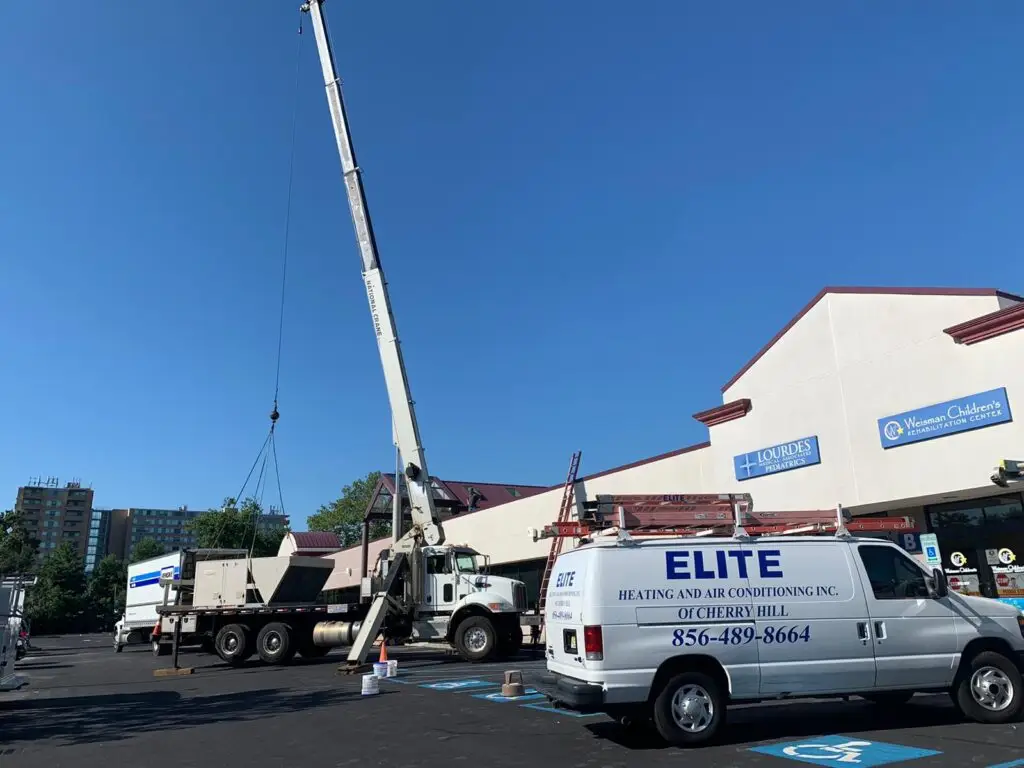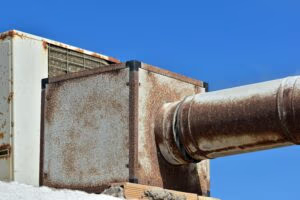Do You Have AC Condensate Leaks? How to Save Your Property
Condensate leaks in commercial HVAC systems are a common but often overlooked issue that can lead to significant damage, system inefficiencies, and health concerns. But the fact that AC condensate leaks are happening isn’t always obvious. When unexpected problems arise, it’s often caused by common condensate leaks.
What is Condensate and How Do Leaks Happen?
Condensate is simply water vapor. It is formed as a byproduct when HVAC systems cool warm, humid air. During cooling, the moisture from the air condenses on the evaporator coil and drips into a condensate pan, (sometimes called a drain pan) from which it is drained through a line.
However, several issues can cause leaks in this process.
- Clogged Drain Lines: Dust, algae, or debris can clog condensate drain lines, leading to overflow.
- Cracked or Rusted Drain Pans: Over time, drain pans may crack or corrode, causing leaks.
- Frozen Evaporator Coils: Frozen coils may cause excess condensation to accumulate, leading to leaks when the ice melts.
How Do You Know If You Have an AC Condensate Leak?
Detecting a condensate leak early can prevent significant damage and reduce costly repairs. While some leaks are visible, others may not be immediately apparent, especially in large commercial buildings.
Property managers and building staff should know the signs that indicate condensate leaks.
Water stains or puddles
One of the most obvious signs of a condensate leak is the appearance of water stains, puddles, or damp areas around the air handler, ductwork, or ceiling tiles. In severe cases, water may accumulate on floors or drip from the ceiling, especially in multi-story commercial buildings.
Increased humidity levels
Condensate leaks can disrupt the normal dehumidification process of your HVAC system, causing the indoor humidity level to rise.
High humidity may result in a sticky or uncomfortable environment for building occupants. If you notice condensation forming on windows, mirrors, or metal surfaces, it could be a sign that the HVAC system isn’t effectively draining moisture due to a leak.
Mold and mildew growth
Persistent moisture from a condensate leak creates the perfect environment for mold and mildew to thrive. Black or green mold patches on walls, ceilings, or near air vents are a red flag. According to the Centers for Disease Control and Prevention (CDC), exposure to mold in commercial buildings can lead to symptoms such as coughing, sneezing, respiratory issues, and aggravated asthma.
The U.S. Environmental Protection Agency (EPA) notes that even small, unnoticed leaks can lead to significant mold growth within 48-72 hours if not addressed.
A property manager’s worst nightmare is finding significant mold growth!
If mold growth is detected, it’s critical to check for condensate leaks in the HVAC system as part of the investigation.
Musty odors
A musty or damp smell is another indicator of potential condensate leaks. This smell often comes from mold or mildew growing in areas where water has accumulated, such as within the ductwork, around the HVAC unit, or in ceiling spaces. If the odor persists even after routine cleaning, it’s likely that excess moisture from a condensate leak is the source.
Poor HVAC performance
If your HVAC system is working harder than usual, it could be a sign of an AC condensate leak.
When a system leaks, it can cause improper cooling or heating performance due to increased humidity and moisture levels. This makes the system less efficient, increasing the likelihood of temperature inconsistencies or warm spots within the building. According to the U.S. Department of Energy, HVAC systems operating with moisture issues or clogged drains can suffer a 15-30% drop in efficiency, leading to higher energy consumption.
Frequent drain line trips
Many modern commercial HVAC systems have built-in sensors, such as float switches, that shut off the system when a condensate drain line is clogged. If your system frequently shuts down due to drain line trips, it could indicate that the system is experiencing regular blockages or leaks. These trips should be investigated promptly to prevent more severe issues.
Visible rust or corrosion
Over time, standing water from condensate leaks can cause metal components within the HVAC system to rust or corrode. If drain pans and nearby ductwork show signs of rust, it may be an early indication of long-standing water exposure due to a leak. Corroded components not only suggest a leak but can also lead to system breakdowns if not addressed.
Impact of AC Condensate Leaks
Structural damage
Condensate leaks can cause substantial damage to the building structure over time.
Water that accumulates around air handlers, ceilings, and walls can lead to rotting, mold growth, and ceiling collapse. The International Association of Certified Home Inspectors (InterNACHI) notes that 90% of water damage claims in buildings involve HVAC systems, with condensate leaks playing a large role. Structural damage is one of the worst consequences of undetected AC condensate leaks.
Inefficiency in systems (and corresponding higher costs)
Leaky HVAC systems are also prone to reduced efficiency.
As leaks divert water away from proper drainage systems, they increase humidity in the building, forcing the HVAC unit to work harder to maintain comfort levels. The U.S. Department of Energy notes that even minor inefficiencies in HVAC systems can reduce performance by up to 30%, contributing to higher operational costs.
Health hazards
Moisture from condensate leaks can promote the growth of mold and mildew, which can trigger allergies and respiratory issues in building occupants. A study by the National Institute for Occupational Safety and Health (NIOSH) found that mold exposure in commercial buildings contributes to health complaints in 40% of workers. The risk is exacerbated in humid regions, where leaks can go unnoticed for extended periods.
Solutions to Common Causes of AC Condensate Leaks
Clean drain lines regularly
The DOE reports that 30% of commercial HVAC system issues are related to blocked drain lines. The solution is to schedule regular maintenance checks, which can involve inspecting and clearing the drain lines to prevent clogs. Commercial property owners should also consider installing float switches, which automatically shut off the HVAC system when a drain line is clogged.
Inspect for cracked or rusted drain pans
Drain pans are typically made of metal or plastic, both of which are susceptible to corrosion or cracking over time. Once damaged, they fail to contain water, resulting in leaks. Regular inspection of the drain pan can help identify early signs of wear and tear. Pan replacement every 10-15 years is recommended.
Check for frozen evaporator coils
Frozen coils may occur due to poor airflow or refrigerant issues. Of all the service calls made, the DOE estimates that nearly 50% of them are because of poor airflow. One of the main culprits with poor airflow is frozen evaporator coils.
Other solutions to common causes of AC condensate leaks are to check refrigerant levels, replace dirty air filters, and ensure proper airflow.
Monitoring and Early Detection Tools to Prevent Leaks and Problems
Several tools and technologies can help detect condensate leaks before they cause significant damage:
Smart Sensors: Smart drain sensors can monitor the water level in the condensate pan or line and provide real-time alerts when a potential leak is detected. These sensors can be integrated with building management systems (BMS) to send notifications directly to the maintenance team.
Moisture Meters: A moisture meter can be used to detect dampness in walls, floors, or ceilings, which can indicate hidden leaks. These tools are particularly useful in areas where the HVAC system is installed out of direct sight, such as in ceilings or behind walls.
Thermal Imaging; Thermal cameras can detect temperature variations in ceilings and walls that may be caused by moisture from a condensate leak. This method is useful for identifying leaks in large commercial spaces without needing to disrupt daily operations.
Customized Commercial Care Plans from Elite Heating and Air Conditioning of South Jersey: The Key to Avoiding Condensate Leaks
Routine HVAC maintenance is the most effective way to prevent condensate leaks and their associated problems. Commercial buildings that follow regular HVAC maintenance programs reduce the likelihood of costly leaks and breakdowns by up to 40%!
Elite Heating and Air Conditioning of South Jersey offers Customized Commercial Care plans. Each maintenance plan is tailored to your specific property – because no two buildings are alike!
Building owners and property managers don’t have to worry about AC condensate leaks – or any other heating and air conditioning problems -when Elite monitors and maintains equipment to prevent problems. Our maintenance plans include performing the following services – just to name a few!
- Drain Line Cleaning: At least once every six months, have your HVAC contractor clear and inspect the condensate drain line.
- Inspection of Evaporator Coils: Ensuring coils remain clean and free from ice formation can reduce condensate buildup.
- Check Refrigerant Levels: Proper refrigerant levels help maintain optimal evaporator coil temperatures, reducing the risk of ice and condensation.
- Installation of Drain Line Sensors: High-quality drain sensors can alert maintenance personnel when a clog occurs, allowing for prompt action before leaks begin. If your system doesn’t have them, we can install them.
In addition, Elite Heating and Air Conditioning can install preventative measures like smart sensors, moisture meters, and deployment of thermal imaging to identify leaks.
Cost Savings Matter to Investors, Building Owners, and Property Managers
Condensate leaks not only cause damage but also impact the energy efficiency of a commercial HVAC system. According to Energy Star, buildings with unaddressed condensate issues could see energy consumption increase by 10-20%. Regular maintenance and timely leak repairs can yield energy savings of up to 15% annually, as HVAC systems will operate more effectively.
In monetary terms, for a medium-sized commercial building with a monthly energy bill of $10,000, an energy-saving measure addressing condensate leaks could save up to $1,500 per year.
A Small Leak, A Big Problem
Condensate leaks may seem like a minor issue, but they can have serious repercussions for commercial properties. From water damage and poor system efficiency to increased health risks, addressing condensate leaks should be a priority for property managers. With routine maintenance and preventative measures, businesses can reduce repair costs, improve energy efficiency, and protect building occupants from potential hazards.
A proactive approach ensures that your HVAC system continues to perform optimally while mitigating the risk of damage caused by condensate leaks.
Call Elite Heating and Air Conditioning Today!
The key to minimizing damage from condensate leaks lies in early detection and rapid response. By staying alert to warning signs such as water stains, mold, musty odors, or increased humidity, building managers can catch leaks before they lead to costly repairs or system failures. Incorporating regular maintenance, inspections, and the use of smart detection tools by Elite Heating and Air Conditioning ensures that you save your property from AC condensate leaks.

- AC condensate leaks, AC leak repair, air conditioner leaks, commercial air conditioning, Commercial HVAC maintenance, common problems in commercial HVAC, condensate, condensate drain issues, Elite Heating and Air Conditioning, Elite HVAC, HVAC troubleshooting, HVAC water damage prevention, property management, protect property from AC leaks, South Jersey, South Jersey HVAC services


